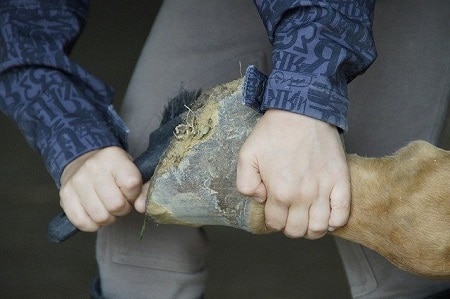Founder refers to a condition in which the horse’s hooves are sore and painful, typically due to an imbalance of weight on its feet, which can result from many different factors.
Founder, also known as laminitis, is a hardening of the tissue in the hoof and can be caused by many factors. The most common reason for founder is an imbalance in nutrients. Horses are left with a difficulty moving about because their pain prevents them from bearing weight on one or more limbs.
Laminitis is an often painful hoof disease which causes inflammation and pain in the feet, making it difficult for horses to walk or work on hard surfaces. It can cause lameness, stiffness, severe colic symptoms that may affect digestion and respiration, weight loss due to decreased appetite and reduced quality of life.
Foals that develop founder often do so between six months and two years old, as they grow faster than normal up until 24 months of age.
What Causes a Horse to Founder?
The most common causes for a horse to get foundered are nutritional deficiencies (such as selenium), lameness issues with the foot or leg, injuries affecting the foot or leg, and just general overuse.
Horses have a sensitivity to the carbohydrate load, particularly when we feed them high-carbohydrate diets. Stressful events like traveling or birth can make horses especially susceptible to Founder because their immune system is weakened and they are more excited than usual.

Horses need carbohydrates in order for energy; however too much at once will cause an overload of undigested sugars and starches that isn’t good for your horse’s health.
Can a horse recover from founder?
The symptoms of founder are weight-bearing lameness with no visible lameness when standing on all fours, head held low, reluctance to move, sensitivity to palpation over the front end of the foot near joints or bone structures that support locomotion (e.g., navicular bone), and/or pain when walking on firm ground surface such as concrete surfaces.
Horses can recover from this founder but they need extensive rehabilitation and medical care as well as time for their hooves to grow out again before they’ll be able to walk without pain again.
There are many treatments available for horses with foundered feet including medications to control inflammation; nutritional therapy consisting of more frequent and smaller meals containing high protein content and exercise management.
What hay is best for Laminitic horses?
Many horse owners choose not to feed hay to their horses because they believe it is too expensive and the horse will find something to eat in a pasture. Horse owners with Laminitic horses are especially hesitant, as they may be told that hay can worsen the condition or lead to weight gain. So what type of hay should you feed your Laminitic horse?
Horses with laminitis are often prescribed hay that is low in sugar and high in fiber for their diet. Hay can vary widely depending on the type of grasses used to make it, so be sure you ask your veterinarian what type of hay they recommend for your horse’s health.
So if your horse is prone to laminitis, then high-quality grass hay will be the best forage option. Rations specially formulated or designed to manage metabolic issues are also options that you and your vet should discuss in order to provide a balanced diet.
Can too much hay cause laminitis? Hay that has a high sugar content can cause laminitis in susceptible animals. One way to help prevent this from happening is by soaking hay before feeding it to the animal so some of the sugar content is removed.
A diet that includes grass hays, which produce lower residue manure and have higher nutrient content than other types of feed such as alfalfa or oat hays should be the main type in your horse’s diet if they are prone to Laminitis.
How long should you soak hay to remove sugar? Allow hay to soak for 30-60 minutes. Soaking the hay longer is not recommended as it can leech out valuable nutrients that help with metabolic conditions such as insulin resistance! The amount of sugar in feed can lead to insulin resistance and other metabolic conditions if too much is ingested at once.
To ensure your horse gets the nutrition it requires from their food source, be sure to drain off any excess liquid for about thirty or so seconds.
Should You Walk a Horse with Laminitis?
Horse owners often wonder if they should walk a horse that has been diagnosed with laminitis. Walking is one of the best forms of therapy for horses and it can be beneficial to both the hoof and the rest of the body, so many people assume that walking would be helpful in treating this condition. However, there are several reasons why you may not want to walk a horse with laminitis.
Before walking a horse with laminitis, remember that, lameness is typically caused by inflammation in the foot or pastern area due to an injury or infection. If your horse has lameness as well as laminitis then it’s likely that one or more structures within his foot have been damaged and will need time to heal before being put under additional stress from walking exercises.
If you have a horse with laminitis, then you may know that horses with laminitis are extremely sensitive in their feet and should not be walked on hard surfaces or gravel, as this can cause pain and swelling.
You could try walking your horse on soft ground or a mat that will absorb some of the impact.
It is important to know what other symptoms are present before considering any treatment plan for your horse’s lameness. Some horses with laminitis will also exhibit signs of colic, which means they’re uncomfortable in their abdomen and might need veterinary attention. Other common symptoms include an elevated heart rate and fever.


